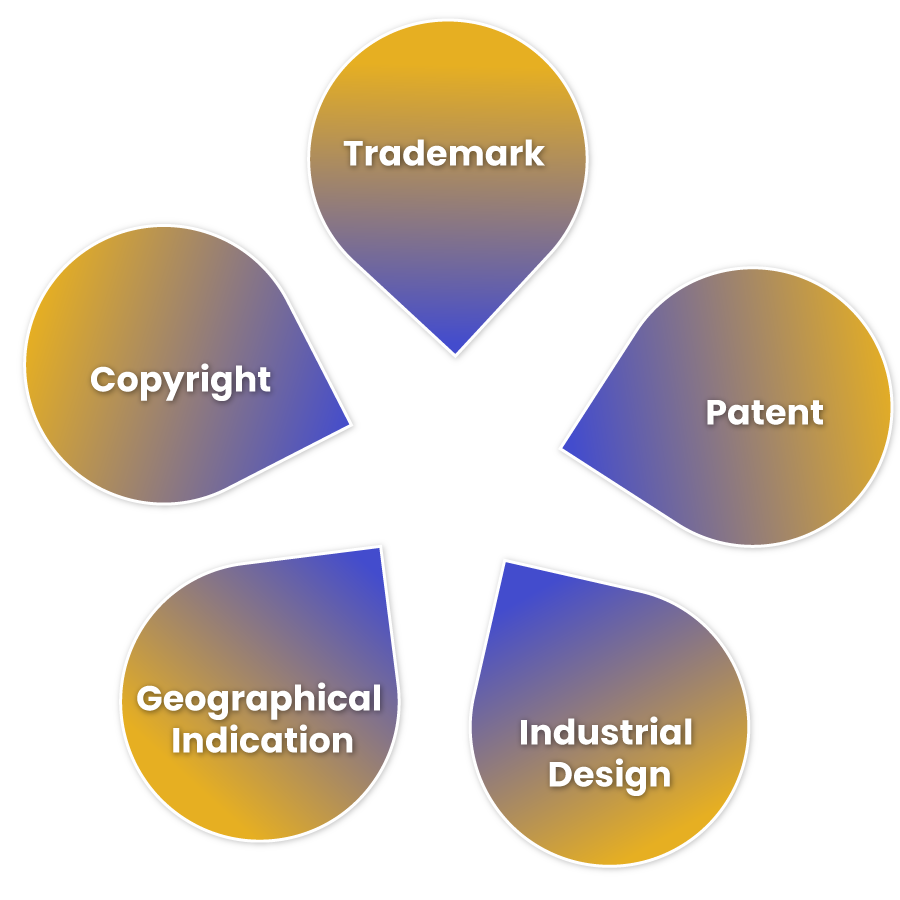What are the Types of Intellectual Property Rights?

Karan Singh | Updated: Mar 24, 2021 | Category: Copyright, Patent, Trademark
Intellectual Property Rights form the basis of society’s improvement. Intellectual Property can be a design, magazine, book, or a different way of manufacturing something. There are different forms of Intellectual Property, but the term property indicates that someone owns it, either by an individual or an entity or an organization. The term property also indicates that it can get protection under the law, and the IP Rights domain very enormous. The most popular Intellectual Property Rights are Trademark, Patent, and Copyright. So, it is essential to know about all the important IP Rights in India. Scroll down to check the different types of Intellectual Property Rights.
Table of Contents
Intellectual Property Rights Law – An Overview
The Intellectual Property Rights Law deals with the rules and regulations related to implementing and protecting legal rights to inventions, designs, and artistic works. The primary objective of Intellectual Property Law is to giving inspiration to people for innovating and developing more creative works that will be beneficial for Society. The Intellectual Property Law has control over tangible assets, just as the law safeguards the ownership rights of personal property.
These rights are not dissimilar from other property rights. It helps the owner or inventor or creator to get benefit from the product, as the product was a first idea which is created or innovated by the owner. The Intellectual Property Rights supports the owner or innovator to safeguard his or her innovation or creation from using, copying, dealing or damaging by some unauthorized person without taking permission from the original owner of the invention. IP Law stops the illegal use of the innovation, and also, the unauthorized user has to pay off for any damages caused. Therefore, the IP Laws help by protecting the original innovation of the people from any illegal use and also provide the owner with exclusive rights to deal with the innovation.
Different Types of Intellectual Property Rights in India
Following are some different types of Intellectual Property Rights in India:

Copyright
The Copyright helps to protect the original piece of work or an innovative. Copyright Registration is granted for writings and different forms of expression. The primary objective of safeguarding the work is to prevent distribution, replication, or unauthorized copying of such works. Copyright Registration doesn’t protect the idea, but it safeguards the expression of an idea. It is the easiest and cheapest form of Intellectual Property Right to get. The universal symbol use for Copyright Protection is ©, and it valid till the person is alive and for seventy years after the expiry of the copyright owner. Some Copyright Protections are automatically formed; however, it is advisable to obtain a Copyright Registration with the registering Copyright Authority in India. Any individual violating the use of Copyright can be sued or fined for Copyright Violation. The regulation related to the Copyright Protection in India is the Copyright Rules, 1958 and the Copyright Act, 1957.
Following are two different components of Copyright Protection:
- Economic Rights: Economic Rights give the owner control or regulate the usage of its innovation or creation in any ways appropriate for the owner. The ways offered to the original owner are making copies, the performance of their work in public, broadcasting, issuing copies of work to the public. Economic Rights also help in attaining an economic reward for the owner’s work.
- Moral Rights: These rights are not transferable, and the owner is given the right to be identified as the original or real owner of the work. The exclusive right to any disfigurement or misrepresentation of work is also given to the owner of the work.
Trademark
It’s a word, symbol, design, or phrase by which a company recognizes their products or services and differentiates them from other products or services supplied or manufactured by other opponents in the marketplace. The main objective of Trademark is to create a link in the customer’s mind between different products or services that a company offers and then distinguish them from other company’s products or services in the market.
A Trademark includes any signs which are capable of being symbolized, particularly words, graphically, including personal names, logos, numerals, or the packaging & shape of goods. The business owner must file an application for Trademark Registration. Trademark registration enhances the owner’s rights by offering legal evidence and the public of the product’s ownership. A Trademark is proof of the exclusive right of the Trademark’s owner and hence, permits the trademark owner to sue the person violating the Trademark use. The Trademark, which is completely registered with the Trademark Registry, is certified to use the ® symbol. A Trademark is valid for ten years, and after that, the owner needs to renew it every ten years as suggested in the Trademarks Act, 1999. Therefore, it can also be said that a Trademark works as an origin’s symbol for a company, business, or brand in order to connect that origin to common customers.
For Trademark Registration in India, the mark has to fulfil some conditions, and you can check the same below:
- The mark should be unique and distinct from other registered marks: A suggested Trademark should not be similar or identical to any other registered trademark because it will reject your application, so to avoid this, you need to do a Trademark Search before applying for Trademark Registration.
- A trademark should not be common: A trademark that has a common description for a general class of products or services, rather than the detailed meaning projected by the Trademark’s owner. A Trademark naturally becomes “general” when the products or services with which the Trademark is associated have gotten significant mind share.
- The Trademark should not be descriptive: A descriptive Trademark is a Trademark that clearly describes any quality, features or aspect of the products or services for which they are used.
- The mark should not be misleading: The Trademark should not incorrectly describe the other similar products or services in the market.
Patent
A Patent provides the owner with an exclusive right to stopother people from abusingthe invention of the inventor or owner mentioned in the Patent. It also gives the right to eliminate other people from using, making, selling, or importing the patented invention of the owner.
A Patent is granted for a particular field in a defined nation and only for a maximum of twenty years. Patent Registration is only be granted if the invention’s owner does the full revelation of the invention and publication of the technical information of the invention. A Patent can safeguard an original invention for twenty years, and after that, you need to renew the Patent. Therefore, a Patent includes a deal between Society and Inventors.
For inventors, a Patent is the most essential to protect their invention from competitors. Whereas, for Society, a Patent holds on to the improvements of the innovation process by making a public confession of the invention. In return for such public confession, investment is fortified by the delivery of individuality of rights and benefits derivative from such inventions.
The regulation which deals with the Protection and Registration of Patent is the Patent Act, 1970, and the Patent Rules, 2003. The Patent Act, 1970, has experienced three modifications in the years 1999, 2002, and 2005. In the year 2005, a modification was introduced regarding the Patent Protection for food, pharma, and chemical inventions.
In India, to obtain Patent Registration, an invention must fulfil some criteria, and you can check the same as follows:
- New or Original: The invention should be original and unique from other inventions and is unknown to the public.
- Utility: The invention is measured as useful and valuable.
- Non-obvious: The originality of the invention should not be obvious to any who has some knowledge regarding the invention. It should be very different and non-familiar to the public.
Industrial Design
It indicates the creation of a shape, combination of pattern, configuration, or colour in 3-D forms of artistic value. In India, the Design Act only safeguards designs that are artistic in nature. An industrial design can be a 2-D or 3-D pattern. Originality and uniqueness are two essential criteria for Design Registration. The designs which are applied by an industrial procedure will only be protected.
The Design Act, 2000 and The Design Rule, 2001 protect the Indian Law of Designs. The Industrial Design Registration grants the design owner the exclusive rights of selling, importing, and applying the design to any product. In India, the first-to-file system is accepted, and this system means that the original owner of the design should file an application for the registration at the initial point of time. The system helps to find out any possibility of any other individual claiming the rights of the proposed designs of the holder. In India, the validity of Design Registration is for ten years, and it is renewable for the next five years. Any individual can apply for the rights of designs.
Following are some conditions require for Design Registration in India:
- The design should be original and new;
- It should not contain any offensive material;
- It should be different from other well-known designs.
- It should not be published in other countries;
- It should not be against any public orders;
- It should be reproducible for any industrial means.
Geographical Indications
It states to an indication that identifies a good as inventing in the territory of a locality, member, or a region in the region, where the reputation, quality, or any other unique features of the good is vitally attributable of the geographical origin of the good.
In India, the Geographical Indications of Goods (Protection and Registration), Act 1999 and the Geographical Indication of Goods (Regulation and Protection) Rules, 2002control the Geographical Indications Registration process. The unregistered Geographical Indication’s owner can impose their rights by passing off a public law remedy.
Conclusion
In recent years, rapid growth is observed in awareness of Intellectual Property Rights amongst the people. Every business in India touches on Intellectual Property Rights and needs the protection of such right as it protects the invention of a business or any individual. From the company’s brand name, any invention made by the company; Copyright, Patent, and Trademark, not only safeguard the rights but also encourages better imaginative expression. Intellectual Property Rights are a noteworthy encouragement for motivating people to invest in innovating, developing, and research projects generally.
Also, Read: Intellectual Property Rights for Business: An Overview














